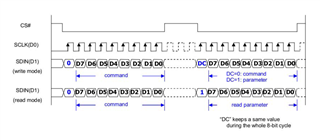Hi,
We have chose LCD which has only 3-Wire support CS, CLK and DI so we have connected that pins with nRF51822 chipset. Now Please see the below image which shows that we have to add 1 bit in 8-bit SPI to identify the Command or Data by the LCD.

I have checked the APIs in SDK but didn't find right solution for this.
So request you to guide in this case.
Thanks in advance
Sachin


